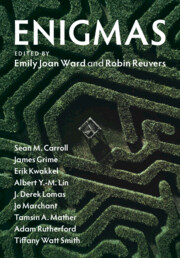46 results
‘A Star Lit by God’: Boy Kings, Childish Innocence, and English Exceptionalism during Henry III’s Minority, c. 1216–c. 1227
-
-
- Book:
- Thirteenth Century England XVIII
- Published by:
- Boydell & Brewer
- Published online:
- 11 January 2024
- Print publication:
- 20 June 2023, pp 125-146
-
- Chapter
- Export citation
Introduction
-
-
- Book:
- Enigmas
- Published online:
- 01 September 2022
- Print publication:
- 18 August 2022, pp 1-9
-
- Chapter
- Export citation
Acknowledgements
-
- Book:
- Enigmas
- Published online:
- 01 September 2022
- Print publication:
- 18 August 2022, pp xv-xvi
-
- Chapter
- Export citation
Contents
-
- Book:
- Enigmas
- Published online:
- 01 September 2022
- Print publication:
- 18 August 2022, pp vii-vii
-
- Chapter
- Export citation
Copyright page
-
- Book:
- Enigmas
- Published online:
- 01 September 2022
- Print publication:
- 18 August 2022, pp vi-vi
-
- Chapter
- Export citation
Figures
-
- Book:
- Enigmas
- Published online:
- 01 September 2022
- Print publication:
- 18 August 2022, pp viii-x
-
- Chapter
- Export citation
Index
-
- Book:
- Enigmas
- Published online:
- 01 September 2022
- Print publication:
- 18 August 2022, pp 229-238
-
- Chapter
- Export citation

Enigmas
-
- Published online:
- 01 September 2022
- Print publication:
- 18 August 2022
Notes on Contributors
-
- Book:
- Enigmas
- Published online:
- 01 September 2022
- Print publication:
- 18 August 2022, pp xi-xiv
-
- Chapter
- Export citation
Chapter 10 - Entering Adolescence
- from Part III - Child Kingship: Guardianship and Royal Rule
-
- Book:
- Royal Childhood and Child Kingship
- Published online:
- 04 August 2022
- Print publication:
- 04 August 2022, pp 249-274
-
- Chapter
- Export citation
Contents
-
- Book:
- Royal Childhood and Child Kingship
- Published online:
- 04 August 2022
- Print publication:
- 04 August 2022, pp vii-viii
-
- Chapter
- Export citation
Figures
-
- Book:
- Royal Childhood and Child Kingship
- Published online:
- 04 August 2022
- Print publication:
- 04 August 2022, pp ix-x
-
- Chapter
- Export citation
Chapter 2 - Children and Kingship in the Early and Central Middle Ages
- from Part I - Royal Childhood and Child Kingship: Models and History
-
- Book:
- Royal Childhood and Child Kingship
- Published online:
- 04 August 2022
- Print publication:
- 04 August 2022, pp 33-52
-
- Chapter
- Export citation
Chapter 6 - The Royal Deathbed
- from Part II - Royal Childhood: Preparation for the Throne
-
- Book:
- Royal Childhood and Child Kingship
- Published online:
- 04 August 2022
- Print publication:
- 04 August 2022, pp 147-168
-
- Chapter
- Export citation
Preface and Acknowledgements
-
- Book:
- Royal Childhood and Child Kingship
- Published online:
- 04 August 2022
- Print publication:
- 04 August 2022, pp xi-xv
-
- Chapter
- Export citation
Chapter 9 - Feasting Princes?
- from Part III - Child Kingship: Guardianship and Royal Rule
-
- Book:
- Royal Childhood and Child Kingship
- Published online:
- 04 August 2022
- Print publication:
- 04 August 2022, pp 230-248
-
- Chapter
- Export citation
Abbreviations
-
- Book:
- Royal Childhood and Child Kingship
- Published online:
- 04 August 2022
- Print publication:
- 04 August 2022, pp xvi-xxi
-
- Chapter
- Export citation
Part III - Child Kingship: Guardianship and Royal Rule
-
- Book:
- Royal Childhood and Child Kingship
- Published online:
- 04 August 2022
- Print publication:
- 04 August 2022, pp 169-282
-
- Chapter
- Export citation
Part I - Royal Childhood and Child Kingship: Models and History
-
- Book:
- Royal Childhood and Child Kingship
- Published online:
- 04 August 2022
- Print publication:
- 04 August 2022, pp 31-82
-
- Chapter
- Export citation
Chapter 8 - Adapting and Collaborating
- from Part III - Child Kingship: Guardianship and Royal Rule
-
- Book:
- Royal Childhood and Child Kingship
- Published online:
- 04 August 2022
- Print publication:
- 04 August 2022, pp 201-229
-
- Chapter
- Export citation



